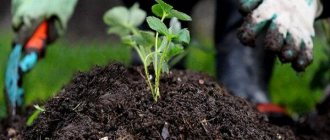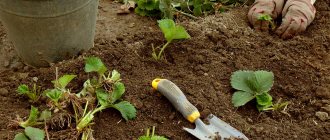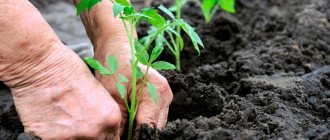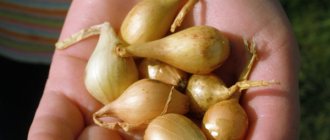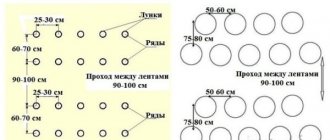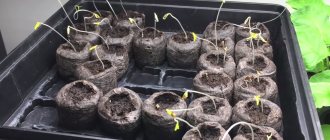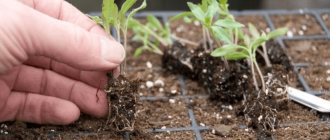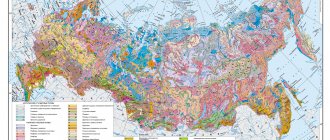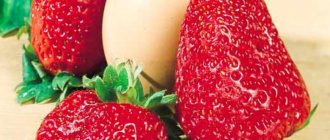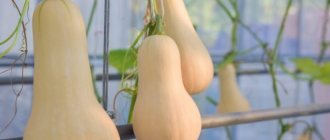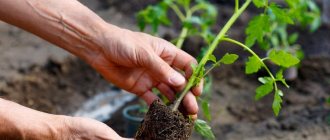Anyone who has encountered growing strawberries and other berry crops is familiar with the situation: you need to constantly pull out weeds, loosen the soil, and also prevent it from drying out. These actions take up a lot of precious time and effort. Of course, you can’t stop watering, but how can you reduce all this to a minimum? Someone solves such problems by mulching strawberries with straw or other materials. But a scientific solution to this issue is also available to the consumer of the 21st century. This is agrofibre (also called agrotextile), a type of spunbond. Covering with this material creates favorable conditions for the growth and fruiting of strawberries. Spunbond is cheaper than agrofibre, but its service life will be significantly shorter. In the article we will look at how to choose agrofibre for strawberries, how to care and water them after planting.
General characteristics of agrofibre
Agrofibre, unlike plastic film, will allow you to freely water strawberry plants and apply fertilizer without removing the covering. This material differs from the well-known film:
- quite light and dense;
- does not fade in the sun;
- inhibits moisture evaporation;
- protects against frost, pests and weeds.
What a close-up of strawberries planted on agrofibre looks like.
Also, a big advantage over other types of coverings is its compactness (easy to fold and remove from the garden) and the ability to use for more than 2 seasons. Sold in rolls (width from 1.5 to 4.2 m) in black and white, has a density range of 17-60 g/m² (the most important performance characteristic). The higher the density of the canvas, the less light it transmits.
Agrofibre weighing 17 g/m² transmits 80% of light, and dense 60 g/m² – up to 67%. For mulch, a material from 50 g/m² is suitable (nowadays a density of 80 g/m² has appeared on the market, but this is a different material - agrofabric). The presence of 4-5% ultraviolet stabilizer guarantees the durability of the agrofibre, and the uniform thickness of the fabric ensures the same temperature in the ground-shelter space.
White agrofibre protects against frost (from -2 to -8°C) and wind;
black is intended to mulch the soil, protect against weeds, and inhibit the spread of diseases. By the way, black is produced exclusively in 50th density. It is possible to use white and black agrofibres simultaneously (you will get rid of weeds and create a positive microclimate not only in the soil, but also on the surface of the site). On sale you will find products from both domestic and foreign manufacturers. Farmers know about the existence of such brands as Agril, Agrotex, AgroSUF, Lutrasil, Agrospan, Spunbond. Depending on the density, the price for this covering material ranges from 10 to 50 rubles per 1 linear meter.
Instructions on how to plant and grow strawberries in agrofibre
Agrofibre for strawberries is a way to grow delicious berries without extra effort. The fabric will solve several problems at once and help you harvest an undamaged berry crop ahead of schedule.
Agrofibre is a non-woven fiber consisting of polypropylene. It is environmentally friendly, does not contain toxins, which means it is suitable for use in the garden.
Properties of agrofibre:
- enhances soil warming;
- protects the soil from hypothermia;
- prevents weeds from developing;
- does not deteriorate from exposure to sunlight;
- allows the soil to breathe, allows air and moisture to pass through;
- can be used for several seasons;
- prevents the development of fungal diseases.
Advantages and disadvantages of using agrofibre
Before using non-woven material for growing strawberries, you need to familiarize yourself with the pros and cons of the method. And also with reviews from gardeners using agrofibre. They can tell you about nuances that manufacturers do not know.
Advantages of growing strawberries on agrofibre:
- Easy to use. Agrofibre can be laid on the garden bed in a few minutes. All that remains is to make holes for the holes and secure the material to the ground.
- The berries will always remain clean. After watering, soil will not stick to them.
- The fruits will not come into contact with the ground. This means they will not spoil and provoke the development of diseases.
- Hilling up the plant will become easier. Strawberry tendrils will grow on the surface of the fiber without growing into the ground.
- The berries will ripen 2 weeks earlier than planned.
- The number of waterings is reduced. Fiber retains soil moisture and protects it from rapid evaporation of moisture.
Flaws:
- Price. Despite the affordable price (from 260 rubles per 10 meters), not all gardeners can afford to buy covering material.
- Thin, cheap material may last less than a season. Easily breaks and deteriorates from moisture and sunlight.
- If the holes are made too large for the strawberry seedlings, soil will fall onto the fabric when watering. This will contaminate the material and require cleaning.
- Agrofibre 17 grams per square meter is prone to the formation of dew on the surface. Excess moisture contributes to the development of infectious diseases.
When purchasing high-quality fiber with a density of 60 grams per square meter, the only disadvantage will be the price. But the positive qualities of the material will contribute to a healthy strawberry harvest.
Types of agrofibre for strawberries
Agrofibre is distinguished by density:
- 17 grams/m2 – protects against frost down to -2 degrees. Transmits 90% of light. Mainly used as a shelter to protect against pests.
- 23 grams/m2 - protects plants from frost down to -5 degrees. Used to insulate greenhouses. Transmits up to 80% of light.
- 30 grams/m2 - protects against frost down to -7 degrees. Transmits 65–70% of light rays. The durable surface can withstand snow and heavy rainfall.
- 50 grams/m2 is used as mulch for strawberries; the fabric does not transmit light. Protects from frost down to -8 degrees. The fabric is durable and can withstand winter precipitation and heavy downpours.
White agrofibre 42, 50 and 60 grams/m2 is used to cover greenhouses and greenhouses.
Black
This type of agrofibre is used to cover the ground as mulch. It has a second name - black spunbond. It has the same density - 50 grams per square meter. Black fabric does not transmit light, which is why the weeds under it die.
Can be used all year round, without replacement. Tolerates winter and protects plant roots from freezing.
White
It has the same purpose as film - it creates a greenhouse effect. But unlike film, white agrofibre allows air and moisture to pass through.
Most often used for greenhouses as shelter:
- the material protects from wind and rain;
- keeps warm;
- allows moisture and air to pass through.
Rarely used for strawberries. At least the material itself will protect the plant from soil erosion during rainstorms and from overheating of the sun. You can use fiber in the autumn-winter period. White agrofibre has different densities up to 60 grams, which will protect the crop during frosts.
Black and white
Also used for covering the ground. The black side is laid down. It has the same properties as black agrofibre for strawberries. And the white side is laid towards the sun. White light reflects the sun's rays and prevents the plant from overheating.
It is recommended to grow strawberries on this type of agrofibre in regions with a hot climate. Fiber density - 50 grams.
Types and price of agrofibre per 10 meters
Black agrofibre 17 grams – 190 rubles Black and white agrofibre – 812 rubles Black agrofibre with strawberry markings – 600 rubles White agrofibre 30 grams – 130 rubles
Timing for planting strawberries under agrofibre in spring and autumn
It is best to plant strawberries under agrofibre in the spring. In regions with hot climates this is done in April, in regions with cold climates - at the end of May. In the spring, seedlings quickly develop, grow and produce new tendrils. Next year you can get a larger harvest of strawberries than when planting in the fall.
In autumn, it is correct to plant strawberries before the onset of frost - in October. In warm autumn it is convenient to work with the soil, and the strawberries will have time to strengthen the roots.
Planting strawberries under agrofibre
The technology for planting strawberry seedlings under agrofibre is simple. The main thing is to choose a bed in a sunny place, with a flat surface. It is better to plant strawberries in the afternoon, when the heat subsides. You need to choose a day that is not rainy, without sharp gusts of wind.
Preparatory process
Before covering the ground with fiber, it needs to:
- dig up;
- clear of weeds;
- disinfect with fungicides;
- add organic fertilizers.
Landing technique
Proper planting of strawberries under agrofibre:
- Let's outline the beds and measure their length and width.
- Let's prepare the material; if necessary, it needs to be cut.
- We will cover the agrofibre and ensure its immobility with heavy objects.
- Let's mark paths for easy processing of strawberries.
- Let's make cross-shaped cuts in the fabric in the places where the planting material will grow.
- We plant strawberry seedlings.
- We water each individual bush.
Strawberry planting scheme
Sometimes the agrofibre already has marks for planting seedlings. If there are none, you need to mark out the locations for the holes yourself at a distance of 20–30 centimeters. The holes are marked in rows, maintaining a distance of 30 centimeters.
If the canvas is wide, it is best to leave space for a path in the center. Otherwise, it will be difficult to care for the central plants.
Mistakes when planting strawberries under agrofibre on Irina Eremina’s channel.
Growing strawberries under agrofibre
Care for strawberries grown on agrofibre is minimal. The absence of weeds and diseases allows the gardener to monitor only the frequency of watering. You also need to regularly feed the plant and monitor the condition of the strawberry berries and leaves.
Watering
Strawberries under agrofibre are irrigated by sprinkling. It is important that the nozzle has small drops; strong jets of water will wash away the soil and expose the strawberry roots. The fiber allows moisture to pass through and retains it in the soil for a longer period than in open ground.
Strawberries need to be watered once a week. On hotter days, 2-3 times a week. 10 liters of water are used per square meter of land.
The water temperature for irrigation should be at least 18 degrees.
In June - July, when strawberries begin to bloom, irrigation should be increased by 2 - 2.5 times, depending on weather conditions. The volume of water per square meter should not exceed 25 liters.
When the berries turn red, watering is reduced to 10 liters. In dry, cool weather, it stops completely. Then the berries that are not watery and dense will ripen.
Top dressing
Strawberries prefer liquid fertilizers. It is better to prepare a solution from granular mineral fertilizers.
Strawberries need to be fed from the second year of life.
Strawberries need mineral fertilizers:
- potassium;
- phosphorus;
- nitrogen;
- magnesium.
The first fertilizers are applied in the spring, after digging the soil. Correctly apply organic fertilizers: humus and manure.
During fruiting, the berries do not need additional feeding. And after harvesting, you should add a fertilizer complex for strawberries or separately diluted mineral granules.
Complex fertilizer in the form of a mixture – 129 rubles Nitrogen – 45 rubles Complex fertilizer in granules – 51 rubles Liquid fertilizer for strawberries – 62 rubles Superphosphate (phosphorus) – 87 rubles Potassium – 90 rubles
We plant strawberries in the best way under agrofibre on Galina Kurpikova’s channel.
Source: https://byton.ru/travjanistye-rastenija/agrovolokno-dlya-klubniki-56735/
Features of agricultural technology when covering with black agrofibre
Volume of the harvest when growing a plant on agrofibre
If sow thistle shoots are even occasionally observed in the strawberry bed , and it belongs to the root shoot weeds , it must be removed. It is advisable to spray with a special herbicide. Why? Remaining under the spunbond, it will begin to grow and lift the canvas upward, and pulling out the sow thistle from under the cover is not so easy!
Remember, a lot of heat accumulates under black agrofibre, which is why in hot weather there is a risk of strawberries overheating. Therefore, after the sun, at sunset, you must water it.
Rules for using covering material
The place for the strawberry plantation is chosen to be bright and well lit by the sun. It is not recommended to plant strawberries after strawberries and raspberries, after onions (after garlic, you can), or after vegetables and flowers of the Solanaceae family (tomatoes, potatoes, peppers, petunias).
It is very important to clear the soil of weeds as much as possible. To do this, various methods are used: keeping the area fallow or green manure for a year, using herbicides, deep digging
The place for strawberries is prepared in advance - green manure is planted, brought to flowering and buried in the ground.
The soil is dug up to a depth of 30-40 cm, carefully selecting the roots of the weeds. The soil is well seasoned with fertilizers. For one square meter of future plantings add:
- 10-15 kg of well-rotted humus or compost,
- half a liter jar of wood ash,
- humates with microelements (according to the packaging instructions),
- 20–30 grams of potassium sulfate,
- 40–50 grams of superphosphate.
Potassium and superphosphate can be replaced with complex mineral or organomineral fertilizer (OMF), preferably specialized for strawberries.
The beds are placed higher if groundwater is close. In other cases, they are only raised slightly or made level with the surface of the earth. Then the soil must be leveled. Before covering with agrofibre, the soil should be given time to settle slightly (15–30 days).
High bed for strawberries made from boards.
Shelter with black and white agrotextiles
This textile appeared recently. This is the best choice. It is superior in functionality to ordinary black agrofibre. It is laid with the white side towards the sun and the black side towards the ground. Consequently, the light surface will reflect the sun's rays from the strawberries and prevent overheating. The dark side will ensure maximum preservation of moisture in the soil. This material promotes uniform fruiting of the berry crop. This option is convenient for farmers in the hottest regions. Its density is 50 g/m²; Use only for mulching berries and vegetables.
Protecting greenhouse paths from weeds
It is believed that strawberry beds need to be treated with herbicides several times throughout the year:
- before planting seedlings in the spring;
- in their first month of growth;
- in summer;
- in autumn;
- in the next couple of years.
Goltix
Betanal
If weeds are actively growing, Glyphosate is suitable. These compositions are used during weed activation, at least two treatments are carried out. By using this chemical composition, you can forget about manual weeding for a long period.
But systemic herbicide formulations are suitable when the grass needs to be destroyed at the time of intensive strawberry growth.
It is believed that the grass grows actively in the first month after planting the strawberries. Therefore, you should immediately use Dactal, which is considered an effective remedy for weeds from the cereal family.
During the summer, you should use PAB or Prism, which are most often used for perennials and annuals. Herbicides containing clopyralid have proven themselves to be quite effective. They penetrate plants through foliage.
Lontrel is effective in controlling dandelions
To prepare the solution, take three hundred grams of the composition per liter of water, the consumption per hectare is five hundred ml of the composition. If the area is lushly overgrown with dandelions, sorrel, chamomile, plantain, and thistle, use Lontrel 300-D. Five milliliters of the composition per liter of water is enough, and with five liters of the resulting solution you can treat one hundred square meters of land.
If there is a need to carry out two treatments, then you should ensure that the dosage of the drugs in total does not exceed the maximum norms for one season. The action of the drugs passes through the soil, so they should be applied on damp soil.
After removing the leaves in the fall, you need to use Lenatsil. This composition perfectly protects against weeds and acts mainly on dicotyledonous plants. After completing the treatment, you should not loosen the beds for several weeks.
In the fall, after removing the strawberry leaves, you need to treat the soil with Lenatsil. Autumn herbicides can cause harm to animals and even people, so when applying them, you should take precautions and strictly adhere to the dosage. If with beds everything is more or less clear (the use of covering material was described above), then with paths the agrotextile laying scheme looks completely different
If with beds everything is more or less clear (the use of covering material was described above), then with paths the layout of agrotextiles looks completely different.
So, in order to completely prevent the germination of weeds in the passages inside greenhouses, you must follow the following points:
- The top layer of soil from the paths is removed and the surface is leveled to prevent the formation of depressions or a noticeable slope.
- The path is well compacted and cleared of stones and large inclusions.
- The prepared area is covered with black agrofibre, always overlapping if pieces of material are used.
- The surface of future paths is covered with gravel, crushed stone or other bulk material with large particles.
- The ends of the agrofibre protruding above the fill are cut off.
Source
Features of planting strawberries under black agrofibre. Which side should I lay?
What does stretched fiber look like for planting with cut holes
? Planting strawberries using black agrofibre is simple. First, prepare the site: fertilize, dig, level with a rake, remove all stones, last year's weeds, roots, and branches. Choose a planting pattern (solid or in rows - one or two close together) and the location of the paths. The width of the latter is selected based on the ease of movement around the site. Then the fiber is laid out on the bed in accordance with the shape. Each subsequent piece must be laid with an overlap (0.25 m). This eliminates the possibility of fiber getting into the track area. Otherwise, walking on the coating will reduce its service life.
According to the chosen pattern, cross-shaped holes measuring 5x5 cm are cut in the mulching agrofibre, with the corners turned inward. There is another option for making holes - this is punching them using a meter-long stick, at the end of which a metal cylinder with pointed edges is nailed (a canned fish tin with a diameter of up to 5 cm). Strawberries are planted at intervals of up to 30 cm, the distance between rows is 40-60 cm.
What black and white material looks like close up
After planting the seedlings, they are safely watered through such a shelter. Along the edges of the strawberry plot, the agrofibre should be pressed to the ground (with slats, rods or stones), or better yet, pinned with pieces of elastic wire or thin reinforcement.
The described technology involves planting strawberries on level ground. But on an industrial scale they practice the use of beds in the form of ridges, which are created using technology or manually. To cover the ridge with agrofibre, the latter is cut into even pieces, which often leaves unused sections. The disadvantage of this method of ridge beds is that when changing crops, transplanting strawberries to another piece of land, the old one needs to be leveled for other crops. Although in the spring the soil on the ridges will warm up sooner (and the harvest will be harvested earlier), the soil dries out faster in the summer and freezes heavily in the winter. Therefore, it is better to grow strawberries on agrofibre on level ground.
Reviews on the use of agrofibre
Nadezhda, Orel: I suffered for a long time from the fact that the strawberries at the dacha were not growing well. I tried to look after her according to the rules. But there was not always enough time for weeding. And it was not possible to water the bushes on time. I decided to lay black spunbond on the area. I had to tinker, but the results were worth it. Strawberries grow well, and I collect a lot of berries.
Olga, Novosibirsk: Everyone loves strawberries, but they are difficult to grow. She is very picky about her care. Either there is not enough moisture, or the weeds will be crushed. I solved the problems in one fell swoop. She laid black material on the new area and planted young bushes. Now the berries have grown and we are pleased with rich harvests.
Nikolay, Moscow: I am an experienced gardener. I have been growing strawberries for a long time in beds covered with black material. At first it was cellophane film, which had to be changed often. Now I covered it with agrofibre, and for several years I didn’t have any trouble with strawberries. When transplanting to a new place, I again use durable fabric. It is just enough for a plantation before the bushes grow old. I’m buying a new canvas for the young people.
Growing strawberries for the modern summer resident is much easier than before. Agrofibre came to the rescue as a mulching substitute. How to use it correctly is described in the material. The article will help you choose the right material and lay it out. Reviews from summer residents will tell you about its advantages.
Caring for strawberries under mulch fiber
Properly planted strawberries with hay paths to prevent weeds
Growing strawberries with agrofibre is easier than in open ground. Care consists of:
- timely watering (carried out as the soil dries out, once every 3 days),
- fertilizing with liquid fertilizer (and only at the root),
- trimming excess mustache,
- fight against diseases.
Water in the evening or morning. If the strawberries were planted later (in autumn), then when the first leaves appear, they are fertilized with complex fertilizer or mullein infusion. When planting in spring, feed before the appearance of flower stalks. It is advisable to fertilize strawberries after harvesting. It is worth noting that in the case of industrial cultivation of strawberries, drip irrigation is used.
How and when to cover plantings
It is better to spread covering material over the surface of the bed when transplanting garden strawberries to a new place - in spring or autumn. It is important to follow some rules
- It is necessary to dig up and prepare the bed in advance, leveling its surface. There should be no stones or other protruding objects on it!
- If the seedlings have already been planted, it is worth covering the entire bed with material, and after that, “feel” for the plants under it and cut holes for their growth.
- It is much more convenient to spread black material on the garden bed in advance, cut cross-shaped holes in it, and plant strawberry bushes in them.
It is better to spread covering material over the surface of the bed when transplanting garden strawberries to a new place
- The ideal scheme for planting strawberries under agrofibre is to leave 40 cm between plants in a row and 45 cm between rows.
- The edges of the covering material must be very firmly secured at the edges. The easiest way to do this is to use metal pins at least 10 cm long or sprinkle the edge with soil.
Modern brands of black agrofibre are treated with special compounds that increase the resistance of the material to ultraviolet radiation
According to experienced gardeners, weeds actively grow during the first time after planting strawberries in spring or autumn. Immediately after the berry planting procedure, the area can be treated with a product such as Dactal. It effectively helps get rid of weeds, especially cereals.
To completely eliminate parasitic grass, complex chemical products that you can prepare yourself at home will help. To do this, you need to mix the following ingredients:
- Fendimifan: 21 g per 1000 ml of water;
- Desmedipham - 71 g per 1000 ml of water;
- Etofumesate - 112 g per 1000 ml of water.
Products that help get rid of weeds in the summer are widely available on the market. You can find them in every farm store. The price varies depending on the effectiveness and quality of the product.
To cleanse seedlings in the summer season, the following pesticides are used:
- A combination of Poax, PUB and Prism. Most often they are used to combat perennial and annual cereal species of parasitic grass. Products with similar properties: Select and Fuzelad.
- To get rid of dicotyledonous annual weeds, you can use Cloper or Clopyralid. They enter the composition of the grass through its leaves. The solution is prepared in the following proportions: 300 g of product per 1 liter of water. In order to cultivate 1 hectare of land, 0.5 liters of this mixture is enough.
- To combat dandelion, sorrel, chamomile, buckwheat, plantain, sow thistle and other dicotyledonous weeds, Lontrel 300-D is used. The product is diluted at the rate of 5 ml per 1 liter of water. 5 liters of solution is enough to treat 100 m².
- Winter parasitic grass can be eliminated with the help of Sinbar and Devrinol. It is recommended not to combine these 2 drugs together, because it is harmful to garden strawberries and strawberries.
You should also not combine soil treatment with Sinbar and a product designed to combat cereal weeds. First of all, it is advisable to use the drug to control cereal weeds, and after 6 weeks the ground can be treated with Sinbar.
Comparison of white, black and black-and-white agrofibre
| Agrofibre | Application | Effect on soil | Weeds | Exceptional differences | Required Density |
| White | Covering material over plantings | Creates a favorable microclimate in the area above the plant and inhibits the penetration of cold there | Suppressed slightly | Protects against birds, insect pests, and inhibits the spread of diseases | 17-60 g/m², depends on expected frosts |
| Black | Mulch | Retains moisture | Completely suppressed | Prevents soil from drying out | 50 g/m² |
| Black and white | Mulch | Retains moisture | Restrains weed growth | Prevents the greenhouse effect in the earth-fiber zone | 40-60 g/m² |
Advantages of growing on agrofibre:
- It has been noticed that areas where agrofibre is used produce greater yields.
- There will be no weathering of soil and moisture.
- There is no need to dig up row spacing.
- When mulching with agrofibre, it is easier for the owner of the site to monitor the spread and growth of the mustache, that is, now a certain orderliness is maintained. You can always see which shoots to pull out and which ones to leave for use (root).
- After rain, the covering material itself is dry, so the berries do not lie on wet soil. She will be clean. This is especially important for owners of large strawberry plantings (excellent presentation is maintained).
- Slugs will not crawl near the berries.
- The operating temperature range of agrofibre is from -55 to +90.
- One of the main advantages: there is no need to weed the soil many times, since weeds do not grow under the black material.
Strawberries grow through the fiber.
Concluding the review of choosing agrofibre for strawberries, it is worth highlighting several points. Agrofibre combines the properties of mulch and the properties of a covering material. Protects young strawberry shoots from burns, while transmitting a sufficient amount of UV rays. Good air and water permeability create the necessary conditions for plant growth; the material does not accumulate water (when wet, it does not increase its mass). Strawberries under agrofibre are watered directly on top. The strength of the material guarantees a long service life. With careful care, agrofibre retains its technical characteristics for 3-4 seasons. It reduces the time for growing these early berries. There is no need to constantly fight weeds or loosen the soil near the shoots.
Preparing the beds
The bed should be located in a well-lit, dry place. Strawberries under agrofibre bear fruit best on loamy and slightly acidic soil. All weeds and debris must be removed from the garden bed.
Apply organic and/or mineral fertilizers to the soil. As a rule, add a bucket of compost to 1 square of land. To the latter you should add a little wood ash and nitrogen fertilizer. Excessively dense soil should be diluted with river sand and carefully dug up.
The soil surface should be smooth and loosened. The bed can have almost any head start, it all depends on the preferences and characteristics of the site.
But, in the northern regions, it is recommended to make them elevated to protect them from groundwater and ensure good heating by the sun.
Preparing strawberries for winterHow to use potassium humate for strawberries: using fertilizer for the garden. Composition, instructions for use and application methods (115 photos + video)
Strawberry Roxana - 85 photos, description, reviews, planting and growing a productive variety
Pros of landing
Planting plants under covering material makes caring for berries much easier. Therefore, if growing strawberries was previously a very labor-intensive task for you, then mulching will solve the problem.
Everyone wants to enjoy these fragrant and juicy berries. But if you spend a lot of time on care, and the resulting harvest is far from expectations, then any desire to grow strawberries disappears. To keep you inspired, there's a great new growing method: mulching. Therefore, the advantages of using covering material for planting berries should be described in more detail.
- Using black mulch film or black agrofibre for covering, you can forget about weed control forever, because these materials do not allow the sun's rays to pass through at all.
- Mulching allows you to create an optimal microclimate in which the soil will not dry out and erode. On the contrary, it will remain loose and moist. In addition, earthworms gather under the covering material, fertilize and loosen the soil - there is also no need for this procedure.
- Plants grown in a mulched bed will be especially strong and strong, as they form many adventitious roots.
- It will become easier to deal with excess mustaches, since they simply won’t have anything to stick to. All you need to do is take scissors and trim off the unwanted tendrils.
- The use of black spunbond allows you to speed up the ripening process of berries. In addition, even in rainy weather, the strawberries will remain clean, since there is no contact with the ground. The use of covering materials also prevents rotting of the berries, which allows them to maintain their presentation and increase productivity.
- Any pests and diseases that are in the soil are not harmful to plants, since the leaves do not come into contact with the soil.
- During winter frosts, even in the absence of snow cover, you will not need to worry about the plants freezing. Over the summer, the soil will warm up well and absorb heat, which will remain in the ground for a long time. Therefore, even spring fluctuations in day and night temperatures will not harm the plants.
Inorganic mulch has a number of advantages over organic covering material - it does not decompose. Organic mulch can soon become a source of proliferation of fungi and bacteria, so planting strawberries under such covering material does not always live up to expectations.
